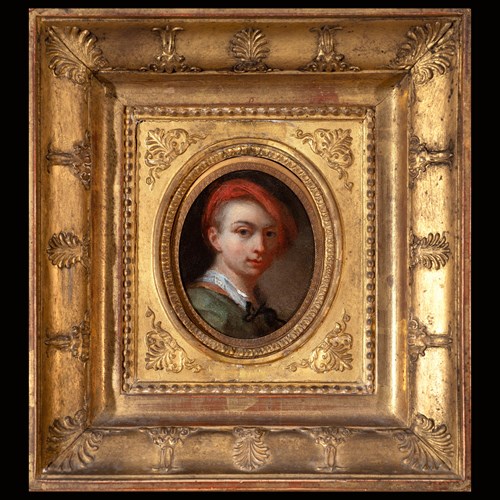SAMUEL BERNARD
Jean-Baptiste Colbert (1619-1683), First Minister of State, wearing black robes, lace jabot and the blue sash of the order of the Saint-Esprit; circa 1676
The Limner Company : Portrait Miniature
Date circa 1676
Medium Watercolour and bodycolour on vellum
Dimension 4.5 cm (1³/₄ inches)
Samuel Bernard had been trained by Louis du Guernier and Simon Vouet and, through his success in art, ended up being one of the founders of the academy of painting and sculpture in Paris in 1848. At the same time, the sitter of this portrait, Colbert, was rising to his first political rank. Known as Le Grand Colbert, he developed an economic approach during his time as the First Minister to Louis XIV that became known as Colbertism. This was a form of mercantilism designed to serve the state, with actions including reducing the number of people benefitting from possessing titles of nobility, increasing the international power of France to compete with the Netherlands, and introducing import tariffs. These tariffs included one on foreign lace, which was banned completely in 1667. It is possible, then, that the unusually large lace Jabot that Colbert is seen to wear here, something that he was often depicted in, was intended to represent his loyalty to national production.
The present miniature shows Colbert circa 1676 and shares some similarities with the depiction of the sitter’s clothing in the pastel portrait in the Musée Condé, Chantilly by the Parisian artist Robert Nanteuil (1623-1678). Colbert’s close relationship with Louis XIV, also known as ‘The Sun King’, cannot be understated. He held almost all the great offices of State - as Comptroller-General of Finances, Secretary of State for the King’s Household, Secretary of State for the Merchant Navy and Superintendent of Royal Buildings, Arts and Manufactories. He met with the monarch five times a week and kept up regular correspondence with him. Colbert’s allegiance to the nation often put him at odds with those in business. Merchants, he repeatedly declared, were little men with only “little private interests”. Colbert’s ideas on taxation were those of almost every minister of finance everywhere, except they were more clearly and far more candidly expressed: “The art of taxation,” he said, “consists in so plucking the goose as to obtain the largest amount of feathers with the least amount of hissing.”
Colbert’s influence extended far and wide during Louis’s reign, even impinging on the people’s leisure activities. Personally, he preferred the Italian opera form to the French ballet and so doomed the latter to the benefit of the Italian import. He also created a theatrical monopoly. In 1673, he forced two existing theatres to unite: when a third troupe was later forced to join them, the Comédie française was thereby formed in 1680. The Comédie française was given a monopoly of all dramatic performances in Paris and was subjected to tight state regulation and control, as it was aided by state funds.
As a man, Colbert gave his entire life to the service of the King, even performing the most personal and sometimes demeaning tasks – for example, he searched for the King’s missing swans, supplied Louis with his favourite oranges, took on arrangements for the birth of Louis’s illegitimate children, and bought jewels for mistresses on the King’s behalf. Colbert’s personal philosophy was best summed up in his advice to his beloved son, Jean-Baptiste Colbert, Marquis de Seignelay (1651–1690), on how to get ahead in the world. He told his son that “the chief end that he should set himself is to make himself agreeable to the king, he should work with great industry, during his whole life to know well what might be agreeable to His Majesty”.
Apart from painting his portrait, Samuel Bernard also had other connections with Colbert. In 1681, the artist was forced to leave the academy of painters and sculptors as he was a protestant, a religious persecution that Colbert had not opposed as the King’s first secretary. From this information it is possible to suggest that the miniature was painted earlier than this date, most likely in the 1670s when Bernard had a comfortable amount of influence within the academy. Furthermore, Bernard’s son would go on to become a famed financier, and it is possible that his path crossed with that of the present sitter.
A member of the artist’s family who previously owned this set of miniatures, Elisabeth, Duchess of Clermont-Tonnerre, published a work on Bernard and his children in 1914.[4]
[1] Catalogue available online, Bibliothèque nationale de France, Notice no. FRBNF31844983.
[2] Two of which are for sale with the Limner Company.
[3] Sotheby’s, London, 5 December 2019, lots 225 and 226.
[4] E. Clermont-Tonnerre, Histoire de Samuel Bernard et de ses enfants, 1914.
Date: circa 1676
Medium: Watercolour and bodycolour on vellum
Dimension: 4.5 cm (1³/₄ inches)
Provenance: By descent within the artist's family to;
Gaspard-Louis, Duke of Clermont-Tonnerre (d. 1889);
by family descent until;
Professor Théophile Alajouanine (d. 1980);
his executor's sale, Paris, Hôtel Drouot, 30 March 1981, lot 37;
with Edwin Bucher, Trogen;
Collection Dr. Erika Pohl-Ströher.
Exhibition: Evreux, 1864. [1]
Paris, Exposition Universelle, 1867.
Plus d'œuvres d'art de la Galerie


, First Minister of State, wearing black robes, lace jabot and the blue sash of the order of the Saint-Esprit _T638816135859193180.JPG?width=2000&height=2000&mode=max&scale=both&qlt=90)

, wearing white dress, the sleeves with blue ribbon trim, matching blue rib_T638780704211238651.JPG?width=500&height=500&mode=pad&scale=both&qlt=90&format=jpg)


-Portrait miniature of a Marshal of France, probably Marshal Louis Francis, Duc d’Boufflers (1644-1711) wearing arm_T638688409312186961.JPG?width=500&height=500&mode=pad&scale=both&qlt=90&format=jpg)
-Portrait miniature of a Lady in a Maroon dress, with lace sleeves and decorative bows, writing a love letter (whic_T638964936523146861.jpg?width=500&height=500&mode=pad&scale=both&qlt=90&format=jpg)
